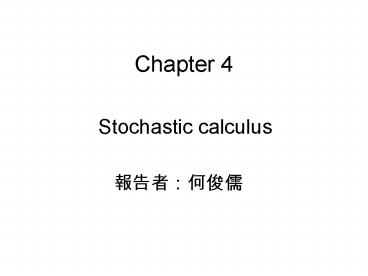Stochastic calculus - PowerPoint PPT Presentation
1 / 34
Title:
Stochastic calculus
Description:
The quadratic variation accumulated up to time t by the Ito integral ... means that Brownian motion accumulates quadratic variation at rate one per unit time ... – PowerPoint PPT presentation
Number of Views:514
Avg rating:3.0/5.0
Title: Stochastic calculus
1
Chapter 4
- Stochastic calculus
??????
2
4.1 Introduction
3
4.2 Itos Integral for Simple Integrands
(4.2.1)
4
Reason for doing this
5
(No Transcript)
6
Trying to assign meaning to the Ito integral
(4.2.1)
We face the problem is that Brownian motion paths
cannot be differentiated with respect to time
7
If g(t) is a differentiable function Define
The right-hand side is an ordinary (Lebesgue)
integral with respect to time
8
4.2.1 Construction of the Integral
To define the integral (4.2.1), Ito devised the
following way around the non-differentiability of
the Brownian motion paths
We first define the simple integrands, and then
extend it to non-simple integrands as a limit of
the integral of simple integrands
9
(No Transcript)
10
(No Transcript)
11
Note
12
(No Transcript)
13
The gain from trading at each time t is given by
(4.2.2)
14
(No Transcript)
15
4.2.2 Properties of the Integral
- The Ito integral (4.2.2) is defined as the
- gain from trading in the martingale W(t)
- 2.I(t) can be thought of as a process in its
- upper limit of integration t, and has no
- tendency to rise or fall
16
Theorem 4.2.1. The Ito integral defined by
(4.2.2) is a martingale
17
Proof
(4.2.3)
18
We must show that
(4.2.4)
(4.2.5)
Adding (4.2.4) and (4.2.5), we obtain
19
To show that the conditional expectations of the
third and fourth terms on the right-hand side of
(4.2.3) are zero
Iterated conditioning
20
(No Transcript)
21
(No Transcript)
22
Theorem 4.2.2. (Ito isometry) The Ito integral
defined by (4.2.2) satisfies
(4.2.6)
23
Proof
24
(No Transcript)
25
(4.2.7)
26
Note that is constant on the interval
, and hence
Substitute the above into equation (4.2.7) to
obtain the following equations
27
(No Transcript)
28
Theorem 4.2.3. The quadratic variation
accumulated up to time t by the Ito integral
(4.2.2) is
(4.2.9)
29
Proof
On one of the subintervals which
is constant We first compute the quadratic
variation accumulated by Ito integral, we choose
partition points
30
(4.2.9)
31
The limit of (4.2.9) is
32
The difference between Theorem 4.2.2 and 4.2.3
- The quadratic variation
- is computed path-by-path, and result can depend
on the path - can be regard as a measure of risk
- depend on the size of the position we take
- The variance of I(t)
- Is an average over all possible paths of
quadratic variation - cant be random
33
Recall the equation (3.4.10),
means that Brownian motion accumulates quadratic
variation at rate one per unit time And the Ito
integral formula can be written in differential
form as
Using (3.4.10) to square
means that the Ito integral I(t) accumulates
quadratic variation at rate per unit
time
34
Remark 4.2.4 (on notation)
(4.2.12)
(4.2.13)































